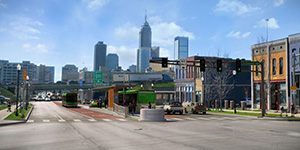Transit Amenities
IndyGo’s system includes more than 4,000 unique stops, and we’ve established a set of guidelines to help determine which investments will be made at each location for amenities such as shelters, benches, bike racks, and solar lights.
IndyGo’s planning staff takes multiple factors into consideration when determining which amenities to place at stops:
- Public right-of-way (ROW)
- Adjacent property zoning
- Ridership
- Access to popular destinations
- Proximity to existing stops and infrastructure
- ADA accessibility
IndyGo is continually investing in infrastructure at stops — not only through direct investments, but also through partnerships with developers, neighborhood groups, the city’s Department of Public Works, and community programs like Adopt-A-Stop.
Shelters make all kind of sense — weather or not.
Shelter sizes can vary, but the typical dimensions are 6’ x 11’. Required infrastructure includes a 5’ x 8’ concrete boarding area, an 8’ x 13’ concrete pad for shelter installation, and a minimum of three feet of unobstructed pedestrian throughway, depending on the orientation of the individual shelter. The stop should service at least 20 passenger boardings a day to warrant a shelter placement.
IndyGo provides installed trash bins at all shelters, and depending on the location, other options may be available, as well, including additional seating, advertisement panels and hard-wired or solar lighting.
Two seats are better than none.
Simme-Seats are twin opposing seats (46” x 16”) affixed to a stop sign post. Installation typically requires a 5’ x 8’ concrete boarding area, an 8” x 8” steel base plate and a minimum of three feet of unobstructed pedestrian throughway. The stop should service at least five passenger boardings a day to warrant a simme-seat placement.
Ride to your stop and park your wheels.
Each bicycle rack can secure two bicycles. The typical required infrastructure includes a 6’ x 4’ concrete pad and a minimum of three feet of unobstructed pedestrian throughway. Each site for a bicycle rack is evaluated on a case-by-case basis.
For safety reasons, bikes are not allowed inside the bus. If the front bike rack is full, wait for the next bus.
How to Load my Bike
- Make sure the bus stops completely and the operator acknowledges that you intend to load your bike on the bus’s front rack before you step in front of the bus.
- If the rack is not already lowered, squeeze the handle on the top of the rack to lower it.
- Place your bike in the rack (it tells you where to put your front tire), then rotate the support arm over the front wheel and you’re done.
- Remember to remove any loose items or valuables from your bike, including panniers, then board the bus and pay your fare.
How to Unload my Bike
- Let the operator know you need to remove your bike and exit through the front door. Never step in front of the bus until you are sure the driver sees you.
- Rotate the support arm off your front tire and remove your bike.
- Fold up the rack if it is empty or simply go on your way!
Make statement in your neighborhood.
IndyGo places trash cans at stops through our Adopt-A-Stop program which is a great way for businesses, community groups, and individuals to help keep litter off their streets and help IndyGo build capacity for maintaining stops. Groups or individuals can have a trash bin and dedicated sign installed on a stop if they make a one-year commitment to pick up litter around their stop and empty the bin when it’s full. IndyGo will provide trash-bin liners throughout the adoption, as well as five one-day passes in appreciation of their support. Stops at stand-alone poles or city street signs are also eligible for adoption.
Brighten your night!
IndyGo can provide traditional hard-wired lighting to any stop where a nearby property owner will allow IndyGo to connect to their electrical power and be willing to pay the subsequent utility charges.
Solar lighting for shelters may be available for those in poorly lighted areas.



